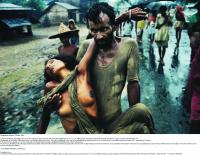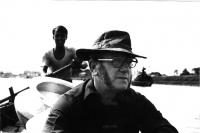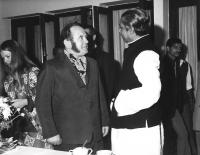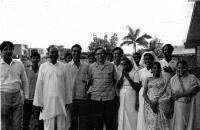Development: ‘Across the gaping earth blasted by hatred’: Concern in Bangladesh
Published in
20th-century / Contemporary History,
Features,
Issue 4 (July/August 2010),
Volume 18

Refugee camp in Calcutta in 1971. A Bangladeshi man carries his cholera-stricken wife—just two of the estimated nine million people who fled the war across the border into India. (Mark Edwards/Still Pictures)
At the beginning of February 1972, Irish Holy Ghost missionary Fr Michael Doheny and members of his Concern volunteer team made preparations for their departure from Salt Lake refugee camp in Calcutta. For months they had operated alongside Caritas India, the Catholic relief agency, providing medical and other assistance to the multitudes fleeing conflict and natural disaster in their homeland of East Pakistan (renamed Bangladesh at independence). Their work, Doheny wrote, gave practical effect to the efforts of the many in Ireland ‘who fasted and begged, of those who organised the fund-raising, of the founders who conceived the ideals and dreamt this dream come true’. Now, as the refugees began their journey home, Concern followed, moving its scene of operations to the newly independent Bangladesh. The plight of the few refugees who remained offered a reminder of the horrors they had faced. Near the camp entrance they came across a fourteen-year-old girl being carried to a truck:
‘. . . she was in advanced stages of smallpox, her whole body terribly disfigured by sores and pus . . . All we could do in the end was give a little alms from Concern Funds.’
Roots in West Africa
Formed under the name ‘Africa Concern’ in March 1968 as a response to the worsening humanitarian crisis and civil war in Nigeria’s eastern region (renamed ‘Biafra’ by the secessionists), Concern had plenty of experience of assisting refugees. For two years its volunteers cooperated closely with Irish Holy Ghost missionaries in Biafra. They raised funds, sourced and distributed supplies and provided important medical relief. But while its roots were in West Africa, the organisation had already planned to continue its work elsewhere in the developing world. Expelled from Nigeria after the end of the conflict in January 1970 by a government suspicious of its links to the rebels, in the following months Africa Concern funded a number of small-scale projects across Africa and Latin America.
The devastating cyclone that claimed 500,000 lives and caused enormous damage to property along the coast of East Pakistan in November 1970 offered an opportunity to return to the theatre of emergency relief. In December Africa Concern’s chief executive, John O’Loughlin Kennedy, travelled first to West Pakistan, then to the East, to assess the situation and to offer the organisation’s ship, Columcille, for use in distributing relief. That offer was declined, but in Dublin Kennedy’s reports had piqued his colleagues’ interest. The following month his brother, Fr Raymond Kennedy, a Holy Ghost missionary who had been at the head of operations in Biafra, returned to the Indian subcontinent to undertake a more detailed survey. With no missionary connections to rely on, however, the effort progressed slowly. This was new ground for Africa Concern, and it proved difficult to find an appropriate means of contributing to the relief effort.
Concern’s Pakistani Famine Appeal

Concern’s Fr Michael Doheny on his travels by boat and (inset) in conversation with Sheikh Mujibur Rahman, first prime minister of Bangladesh. (John O’Loughlin Kennedy and Kay Kennedy).
In the meantime, the escalating crisis had forced millions of refugees into worsening conditions in camps across India. When Raymond Kennedy returned in mid-May on a seventeen-day fact-finding mission to Calcutta, Bongaon, Nadia and West Dinajpur (during which he at one point ‘accidentally’ crossed the border into East Pakistan and was held for five hours by Pakistani soldiers), what he saw was enough to prompt Africa Concern into immediate action. On 7 June 1971 the organisation launched its Pakistani Famine Appeal, fronted by the slogan ‘Brother, can you spare a pound?’ It called for Irish men and women to contribute one week’s drink and tobacco money, and returned to tactics developed during the campaign for Biafra—fasts, walks and ‘hunger lunches’. The appeal successfully captured widespread public support. By the middle of July donations had reached £50,000, and Concern had been joined in its efforts by a number of other Irish organisations. In June alone, the Irish Catholic hierarchy pledged £60,000 for Pakistani refugees, followed by Irish government donations totalling £50,000 to UNICEF, the UNHCR and the Red Cross, and the launch of a Gorta East Pakistan appeal.
These organisations may have differed in approach but they were united in their desire to assist the refugees. Their attitudes were exemplified by Dr Joseph Barnes, a veteran of West Africa and the relief campaign in Biafra. Beginning with a simple question—‘Are we needed again?’—Barnes helped to organise an Africa Concern medical team that left Ireland in July, bound for refugee settlements in the Garo Hills, 800 miles north of Calcutta. The team’s efforts were short-lived, however. In early August the Indian government ordered all ‘uninvited’ personnel to leave the country, insisting that it had sufficient medical resources of its own to deal with the crisis.What appeared at first to be a major setback in fact ushered in a new phase in Africa Concern’s operation. While two of the medical team returned to Ireland following the withdrawal, the others—one doctor and three nurses—continued to Calcutta and Salt Lake camp to assist Caritas India in its operations. By the time Fr Michael Doheny arrived in November 1971 the organisation had dropped the ‘Africa’ from its name, calling itself ‘Ireland Concern’ or simply ‘Concern’. His small group of volunteers won widespread admiration, but their efforts were matched by moments of considerable sadness. On 18 January 1972, Jean Browne, a nurse from Castleisland, Co. Kerry, died after contracting cerebral malaria, the first loss of a Concern volunteer while on duty abroad.
Into Bangladesh

While the medical team continued its work in Salt Lake, Concern’s directors were busy planning for the end of the conflict. Raymond Kennedy spent six weeks touring East Pakistan in November and December, and followed it by meeting officials from the Bangladeshi office in London to discuss the admission of a Concern team after independence. When the conflict ended, Michael Doheny followed in his footsteps, spending a further eight days touring the newly liberated state. He found the Bangladeshi capital Dacca ‘like a corpse come back to life’, and with it considerable opportunity for Concern to contribute to its reconstruction.
Two months later, in February 1972, Doheny was back, leading the Concern team from Salt Lake camp to its new field of operations. The move was vital for the organisation’s future. In Biafra its emphasis had, of necessity, been on emergency aid; Bangladesh offered an opportunity to put the ‘extraordinary’ generosity of the Irish people to work on a programme of long-term assistance. In the first half of 1972 the team focused on carefully putting together a development strategy, forging close links with the Bangladeshi coordinator of external assistance, Adbur Rab Chaudhury, and a number of local and international NGOs. One of Concern’s earliest initiatives, a women’s career training institute in Dacca run by volunteer Mary Humphreys, provided a clear indication of its intentions. Opened in May 1972, the institute offered classes in sewing, doll-making and other handicrafts that were later sold in Concern craft shops across Ireland. Its goal—to help the people of Bangladesh to help themselves—was extended to all aspects of Concern’s work. Under the eyes of Fr Aengus Finucane, who succeeded Raymond Kennedy as field director in September 1972, Concern volunteers built tubewells, replaced bridges and helped build 2,000 homes for returning refugees. They ran hospitals and medical dispensaries, opened a rehabilitation programme in Rangpur, assisted in the running of the Chittagong Government Commercial Institute, and opened schools in six rehabilitation camps for the Bihari minority group at Saidpur.
The spectre of natural disaster was never far away, however. In June 1974, devastating floods brought displacement, disease and widespread famine to five million people across Bangladesh. Concern’s response reflected its growing maturity as an NGO. As well as the provision of immediate emergency relief in the form of food and medicine, Finucane spoke of the necessary ‘restoration work’ that would begin ‘as soon as the waters recede sufficiently to allow inspection’. At the request of the Chittagong authorities, one of the first volunteers on the scene was Concern engineer Hugh Byrne, whose remit included the rebuilding of earthwork river embankments, riverside homes, small village bridges and the rescue of tubewells submerged and contaminated by the rising waters.
As an organisation, Concern continued to grow alongside the youthful state of Bangladesh. Its operations there became a pillar of its success, marking its move from reactive emergency aid to the twin goals of relief and a proactive contribution to development. It was also instrumental in the creation of the Irish NGO system as we know it today, not only by prompting interest in the field and helping to stimulate the activities of Trócaire, Gorta and the others that followed, but also in the manner in which it deployed its resources and personnel. In March 1974 there were 35 professionally qualified Concern volunteer doctors, nurses, social workers, teachers, secretaries and administrators on the ground in Bangladesh, each on a one-and-a-half-year period of service. They were there because, as Mary Wall, an Irish nurse who returned from Salt Lake camp in 1972, recalled, ‘I wanted to do something, and this was something I could do’. But the nature of volunteering had taken on an additional aspect. Individuals were increasingly recruited for the specific skills they offered Concern and the people it served in the developing world.
Debates, difficulties and competition

John O’Loughlin Kennedy (centre), co-founder and chief executive of Concern, with doctors and nurses at Dinajpur hospital in September 1972 (John O’Loughlin Kennedy and Kay Kennedy).
In spite of its success in the field, Concern was haunted by a number of difficulties. From 1972 serious debate developed within the organisation about its direction, the appropriateness of its structures, the level of clerical involvement and the role played by a number of its prominent personalities. Clashes over Raymond Kennedy’s leadership style in Bangladesh, for example, had led him to hand over the role of field director to Aengus Finucane, although the following March Kennedy took over as Concern’s executive director after his brother John’s departure to a role with An Taisce. There were further squabbles over fund-raising, which continued to be a problem. The organisation was fond of restating its slogan ‘rich in people’ while admitting that it was ‘poor in resources’. In spring 1973 it warned that ‘if we do not get an injection of money and get it quickly we may have to close down, or at least seriously curtail our programmes’.
If that was not enough, Concern faced increased competition for those resources. Where it went in Bangladesh, Gorta, founded in 1960 with an emphasis on long-term agricultural development, followed, with projects of its own in fishing and poultry. In 1973 the Catholic hierarchy founded its own agency, Trócaire, which by the end of the following year had allocated over £400,000 to the developing world. Other changes ensued. In 1974 the Irish government launched its first official aid programme and created the Agency for Personal Service Overseas (APSO) to provide funding for Irish volunteers. Three years later journalist John O’Shea and four colleagues established GOAL.
By then, aid, Irish-style, had consolidated its position in the public consciousness. Its origins lay in the Christian missions, ‘pennies for black babies’ and widespread sympathy for the plight of Biafra. The generous public response to the plight of Bangladesh, an area with little or no Irish missionary tradition, created a new link, establishing a pattern of generosity repeated from Ethiopia in the 1980s and Somalia in the 1990s to the recent earthquake in Haiti, where Concern itself has been active since 1994. HI
Kevin O’Sullivan is an IRCHSS postdoctoral fellow at the School of History and Archives, University College Dublin.
Further reading:
T. Farmar, Believing in action: the first thirty years of Concern, 1968–1998 (Dublin, 2002).
E. Staunton, ‘The case of Biafra: Ireland and the Nigerian civil war’, Irish Historical Studies 31 (124) (Nov. 1999), 513–35.
W. van Schendel, A history of Bangladesh (Cambridge, 2009).


 While the medical team continued its work in Salt Lake, Concern’s directors were busy planning for the end of the conflict. Raymond Kennedy spent six weeks touring East Pakistan in November and December, and followed it by meeting officials from the Bangladeshi office in London to discuss the admission of a Concern team after independence. When the conflict ended, Michael Doheny followed in his footsteps, spending a further eight days touring the newly liberated state. He found the Bangladeshi capital Dacca ‘like a corpse come back to life’, and with it considerable opportunity for Concern to contribute to its reconstruction.
While the medical team continued its work in Salt Lake, Concern’s directors were busy planning for the end of the conflict. Raymond Kennedy spent six weeks touring East Pakistan in November and December, and followed it by meeting officials from the Bangladeshi office in London to discuss the admission of a Concern team after independence. When the conflict ended, Michael Doheny followed in his footsteps, spending a further eight days touring the newly liberated state. He found the Bangladeshi capital Dacca ‘like a corpse come back to life’, and with it considerable opportunity for Concern to contribute to its reconstruction.

















